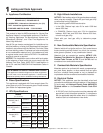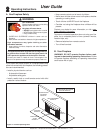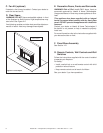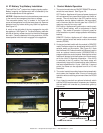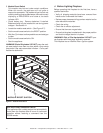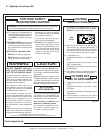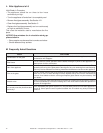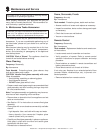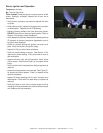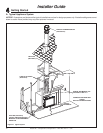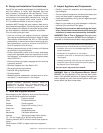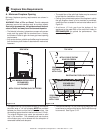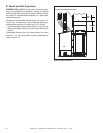Heat & Glo • Escape-I35-C, Escape-I30-C • 2201-901 Rev. H • 5/12 14
Venting
Frequency: Seasonally
By: Homeowner
Tools needed: Protective gloves and safety glasses.
• Inspect venting and termination cap for blockage or
obstruction such plants, bird nests, leaves, snow, debris,
etc.
• Verify termination cap clearance to subsequent construc-
tion (building additions, decks, fences, or sheds). See
Section 6.
• Inspect for corrosion or separation.
• Verify weather stripping, sealing and fl ashing remains
intact.
• Inspect draft shield to verify it is not damaged or missing.
B. Maintenance Tasks-Service Technician
The following tasks must be performed by a qualifi ed
technician.
Gasket Seal and Glass Assembly Inspection
Frequency: Annually
By: Service Technician
Tools needed: Protective gloves, drop cloth and a stable
work surface.
• Inspect gasket seal and its condition.
• Inspect fi xed glass assembly for scratches and nicks that
can lead to breakage when exposed to heat.
• Confi rm there is no damage to glass or glass frame.
Replace as necessary.
• Verify that fi xed glass assembly is properly retained and
attachment components are intact and not damaged.
Replace as necessary.
Logs
Frequency: Annually
By: Service Technician
Tools needed: Protective gloves.
• Inspect for damaged or missing logs. Replace as necessary.
Refer to Section 12 for log placement instructions.
• Verify correct log placement and no fl ame impingement
causing sooting. Correct as necessary.
Control Compartment and Firebox Top
Frequency: Annually
By: Service Technician
Tools needed: Protective gloves, vacuum cleaner, dust
cloths
• Vacuum and wipe out dust, cobwebs, debris or pet hair.
Use caution when cleaning these areas. Screw tips that
have penetrated the sheet metal are sharp and should
be avoided.
• Remove all foreign objects.
• Verify unobstructed air circulation.
Firebox
Frequency: Annually
By: Service Technician
Tools needed: Protective gloves, sandpaper, steel wool,
cloths, mineral spirits, primer and touch-up paint.
• Inspect for paint condition, warped surfaces, corrosion
or perforation. Sand and repaint as necessary.
• Replace appliance if fi rebox has been perforated.
Surface cracking or crazing of fi rebrick material is normal
and expected. The following types of cracks are acceptable
and do not require replacement of the unit or the fi rebox:
• Cracks that do not propagate entirely through the
material.
• Light fracture lines or “spider-webbing” on the surface of
the material.
• Cracks that are less than 1/32 in. wide and less than 3
in.long.
• If cosmetically unacceptable, such cracks may be
repaired with the SRV-PACK service kit.
Cracks that are unacceptable and require maintenance:
• Cracks greater than 1/32 in. wide and 3 in. long are at
risk of growing.
• Cracks that penetrate entirely through the firebrick
material.
• Cracks that extend past the inner wall to the glass sealing
fl ange.
Inspection for cracking should be run when the appliance
is cool. Cracks tend to close as the appliance heats up.
The crack may be repairable with the PATCH-KIT-FB.
Report the case to a Product Specialist with Hearth &
Home Technologies.
Light Bulbs
Frequency: As needed
By: Service Technician
Tools needed: Protective gloves, replacement light
bulbs. 1/4 in. nut driver.
• Remove the glass frame. See Section 12.I.
• Remove the logs, grate, and burner.
• Remove the two ember glass retainer tabs.
• Remove the ember glass.
• Replace light bulb.
• Reassemble components in reverse order of disassembly.



